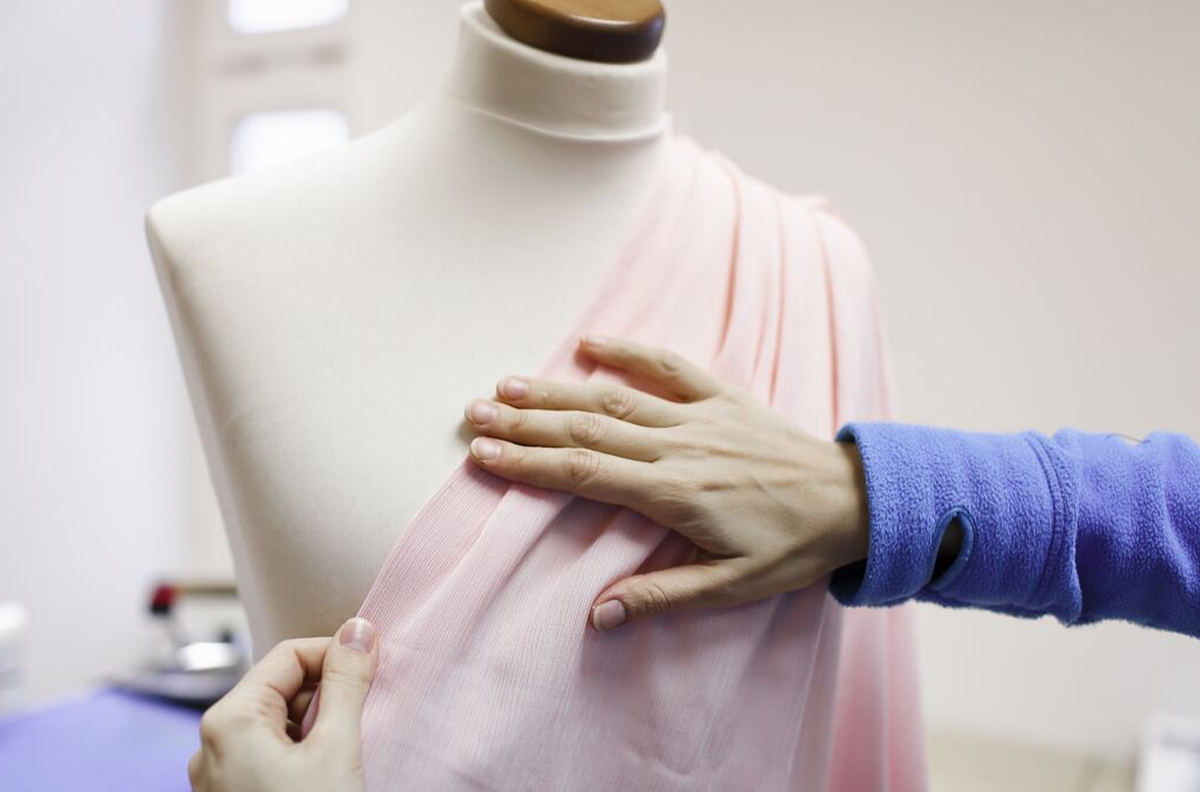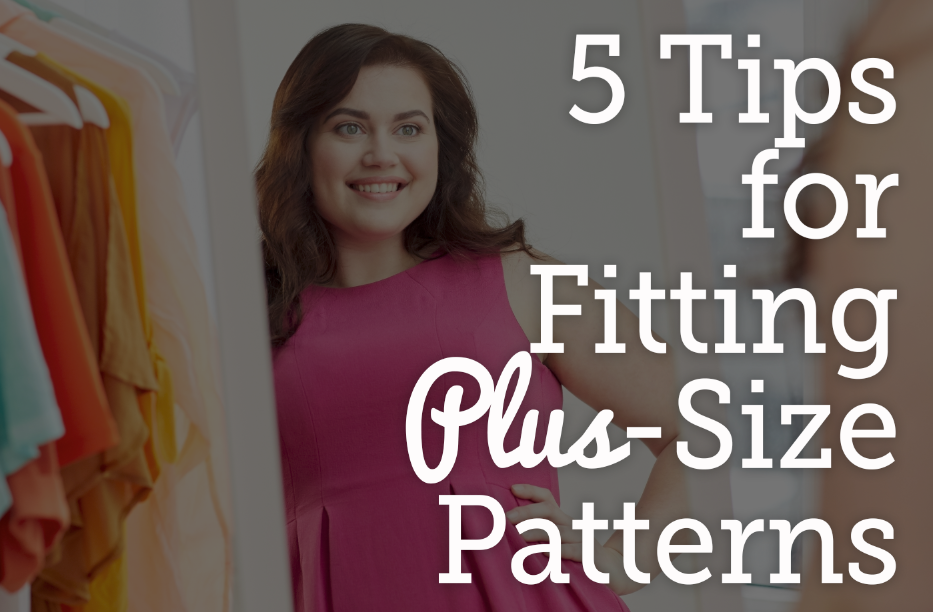Sewing can be a challenge even when using pre-drafted patterns and available resources. For garments intended for plus size sewing, however, more challenges may present themselves than the average sewer has ever encountered. Fortunately, there are some easy tips that can keep you sewing beautiful garments no matter the size.

Related Video: Plus Size Sewing and Fitting Tips
1. Select styles that work well for plus sized wear
Before you ever break out the fabric scissors, consider what garments you want to create and search for styles that work well for plus sized wear. This doesn’t mean you have to choose all shapeless or baggy clothing. Not at all!
Many garment features work particularly well for fitting numerous body types and can thus be useful when plus size sewing. Styles with looser sleeves, cap sleeves, or sleeves that are sewn to the neckline rather than set in an armhole provide more mobility and easier fit. A-line garments often require less fitting below the bust – a great style for those with curves who would otherwise need lots of tailoring. Even pencil skirts and fitted garments can work to smooth a silhouette.
Before you ever start sewing, consider what styles will work best for you and, if you are a beginning sewer, what styles will require the least fitting and alteration.
Related Video: Sewing Pattern Alteration and Tools

2. Choose the right pattern
Just like choosing the right style, choosing patterns is an important step to the sewing process. With so many patterns available, it is important to consider your options and your sewing expertise. Look for patterns that have points where the garment can be tailored to fit for plus size wear. Princess seams, for example, are easily adjustable in numerous places along the torso; this minimizes the need to dart or adjust the garment in an awkward location.
Be wary of pattern scaling as well. Many larger sized garments also increase in length as well as width. If you choose a pattern by a plus size bust size, for example, you may find that the torso length has increased and the garment no longer fits properly. To avoid this, be sure to look at length measurements before you purchase. It is far easier to add adjustments to the width of a pattern to accommodate bust than it is to adjust the length of a torso. Some pattern companies now also offer plus size patterns designed to reduce this problem.
Related Video: Full Bust Adjustment Tutorial
3. Measure carefully
Body measurements are always important for any sewing project but they are a critical piece of plus size sewing. With more curves, plus size wearers often have more variance in measurements than one might need for a standard pattern drafting.
Be sure to measure yourself accurately and take appropriate measurements before starting. Your bust, hips, and waist may not be enough to provide accurate measurements for the entire process. Many sewers want multiple measurements for each such as upper bust, under bust, upper waist, and more.
Related Video: The Right Measuring Tool for Pattern Making

4. Invest in a dress form
Dress forms can make drafting simpler and easier if you are adjusting a pattern or mock up before sewing. For plus size sewers, an adjustable dress form lets you see problems before you finish the garment and lets you adjust accordingly.
Even with careful measuring and pattern adjustment, clothes will sometimes still need an adjustment. This is much easier to see on a dress form, where a seam can be adjusted, darts taken, or problems easily viewed.
Related Article: How to Alter a Sewing Pattern
5. Choose the right fabrics
Choosing the right fabrics for your sewing project is always critical but is particularly so when choosing fabrics for plus size sewing projects. Knits and stretch fabrics may be more forgiving for a curvy fit. Fabrics with a crisp feel or “hand” may be easier to sew and thus easier to adjust and alter.
Beginning sewers will need to balance their knowledge and ability with suitability as well; knit fabrics can be more difficult to sew with. For a plus size garment, ensure whatever fabric you choose is suitable to the pattern, garment style, and the body type of the wearer.
Related Video: Tricky Fabric Stitching Techniques
With a little planning and forethought plus size sewing offers a rewarding project that lets people of all shapes and sizes create fashionable, comfortable garments. What are your tips for sewing with and fitting plus-size patterns? Let us know in the comments!

Have something to add? Leave a comment or email editor@nationalsewingcircle.com.

Over the years I have found that the princess style works pretty well for me because there are a bunch of seams I can add or take from for a nice fit. I'm 5' 2'' and 200 # at the moment.
Hi---New member---Would like to see fitting on upper arms. Thanks Joan Kosal
I've found it helpful to dowaist' high and low hip and thigh measurements while sitting as well as standing. to allow a little ease to the sitting aspect of the garment has made a lot of difference in my fit as has learning the true use and meaning of darts. thanks for this info here too.
I agree using a dress form has improved the fit of the clothes l sew for myself, so much easier than try to look at the fit on your body. In Reply to Lisa & Brooke’s post about getting a dress form to fit your shape, you don’t have to pad one, and l found the bust is too high anyway. There is a company called Bootstrap Fashions. You send a whole lot of your body measurements (you need someone to help with these) and they send a pdf pattern of your body double to make the dress form. It does not look as perky as traditional dress form , but oh so much more useful. The cost is modest, no more than a couple of paper dress patterns and they have a very helpful video on line of how to sew the pattern. ,
<strong>In any of these videos do you cover plus sized petite adjustments. I am smaller in the top than bottom ( I am B cup) so I end up with tops that have too wide to deep neck lines with shoulders half way down the deltoid and sleeves that are inches far too long. Then I end up with pants that the crouch ends up to the knees and way too long. So I am short and squat with normal arms and legs and neck and rolly poly in the middle. How do I adjust for that
Very easy to read and understand. Thank you. My problem is my awful lower 'tummy'. How do I alter my dress form to allow for this without cutting baggy garments?
<strong> Ticket 19606 Most plus size dress forms only go just so big and that leave a lot of us ladies scratching our heads because that, in the moment, leaves us with just "making do". Even though we are large ladies we's still like to have that nice, neat, tailored look. The kind that makes us look attractive but still conceals what flaws that need concealing. So, on to my question. How can we make our own dress forms specifically for the size we need for our personal body shape{s}? Thank you to anyone who has any suggestions for this.
It's really nice to know about this post. Having curves and shopping for plus-size clothing can be a little bit difficult at times but those "5 tips for fitting plus size patterns" you posted is very helpful and understanding. Buy Curvy has affordable cute and trendy stuff for plus size women you can choose whatever you want such as clothing, accessories, swimwear, and anything that will look you beautiful and fabulous.
My house help's aunt asked me to make her a straight skirt but she must be at least a size 54 to 56. Please correct me if I'm wrong in my calculations of adding at least 2 sizes on plus seam allowance to be on the save side. Calculating the amounts to be added on and dividing each pattern piece's extra inches to be add on both sides of the side seams. Thank you
And your point is...? I am a pattern drafter. This didn't help. I wanted "TIPS", not common sense. What about measuring the bust, not the rib cage? What about proper ease for larger women? Good grief, we didn't start sewing yesterday! What about a good basic pattern FITTING pattern for larger women that they can sew w/zipper, put over their their dress form and stuff, so they have something to DRAPE on and DRAFT patterns. See OLD vogue patterns on eBay for these basic looking dresses that you fit on your own body then put on your dress form and stuff (use one inch seams so you can let it out if needed. Add a zipper down the back). Not everyone is a size 8! Plus doesn't need to mean grossly lacking in fit and style! It's not that hard to learn to draft patterns, ladies! Get at it. Take your favorite jeans (no stretch!) Find the straight grain down the middle of the leg and pin muslin over it. Then mark the seams and add seam allowance (always one inch when creating new patterns for you) and inch and a half plus seam allowance (room) for the zipper. REMEMBER, Levis cuts one leg off grain to save fabric and money. you can correct this defect (seam wrapping around your leg off grain) rather than running straight up and down as it should.